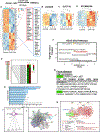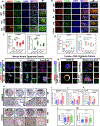Cancer-Associated Fibroblast Induces Acinar-to-Ductal Cell Transdifferentiation and Pancreatic Cancer Initiation Via LAMA5/ITGA4 Axis
- PMID: 38154529
- PMCID: PMC11694316
- DOI: 10.1053/j.gastro.2023.12.018
Cancer-Associated Fibroblast Induces Acinar-to-Ductal Cell Transdifferentiation and Pancreatic Cancer Initiation Via LAMA5/ITGA4 Axis
Abstract
Background & aims: Pancreatic ductal adenocarcinoma (PDAC) is characterized by desmoplastic stroma surrounding most tumors. Activated stromal fibroblasts, namely cancer-associated fibroblasts (CAFs), play a major role in PDAC progression. We analyzed whether CAFs influence acinar cells and impact PDAC initiation, that is, acinar-to-ductal metaplasia (ADM). ADM connection with PDAC pathophysiology is indicated, but not yet established. We hypothesized that CAF secretome might play a significant role in ADM in PDAC initiation.
Methods: Mouse and human acinar cell organoids, acinar cells cocultured with CAFs and exposed to CAF-conditioned media, acinar cell explants, and CAF cocultures were examined by means of quantitative reverse transcription polymerase chain reaction, RNA sequencing, immunoblotting, and confocal microscopy. Data from liquid chromatography with tandem mass spectrometry analysis of CAF-conditioned medium and RNA sequencing data of acinar cells post-conditioned medium exposure were integrated using bioinformatics tools to identify the molecular mechanism for CAF-induced ADM. Using confocal microscopy, immunoblotting, and quantitative reverse transcription polymerase chain reaction analysis, we validated the depletion of a key signaling axis in the cell line, acinar explant coculture, and mouse cancer-associated fibroblasts (mCAFs).
Results: A close association of acino-ductal markers (Ulex europaeus agglutinin 1, amylase, cytokeratin-19) and mCAFs (α-smooth muscle actin) in LSL-KrasG12D/+; LSL-Trp53R172H/+; Pdx1Cre (KPC) and LSL-KrasG12D/+; Pdx1Cre (KC) autochthonous progression tumor tissue was observed. Caerulein treatment-induced mCAFs increased cytokeratin-19 and decreased amylase in wild-type and KC pancreas. Likewise, acinar-mCAF cocultures revealed the induction of ductal transdifferentiation in cell line, acinar-organoid, and explant coculture formats in WT and KC mice pancreas. Proteomic and transcriptomic data integration revealed a novel laminin α5/integrinα4/stat3 axis responsible for CAF-mediated acinar-to-ductal cell transdifferentiation.
Conclusions: Results collectively suggest the first evidence for CAF-influenced acino-ductal phenotypic switchover, thus highlighting the tumor microenvironment role in pancreatic carcinogenesis inception.
Keywords: Acinar–Ductal Metaplasia; Pre-Neoplastic Pancreatic Lesions; Stroma Secretome.
Copyright © 2024 AGA Institute. Published by Elsevier Inc. All rights reserved.
Conflict of interest statement
COMPETING INTERESTS
SKB is one of the co-founders of Sanguine Diagnostics and Therapeutics, Inc. The other authors declare no competing interests.
Figures







References
-
- Rahib L, Smith BD, Aizenberg R, et al. Projecting cancer incidence and deaths to 2030: the unexpected burden of thyroid, liver, and pancreas cancers in the United States. Cancer Res 2014;74:2913–21. - PubMed
-
- Siegel RL, Miller KD, Wagle NS, et al. Cancer statistics, 2023. CA Cancer J Clin 2023;73:17–48. - PubMed
Publication types
MeSH terms
Substances
Grants and funding
LinkOut - more resources
Full Text Sources
Medical
Molecular Biology Databases
Research Materials
Miscellaneous

